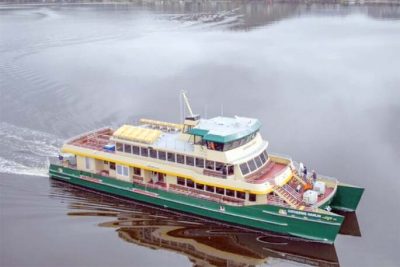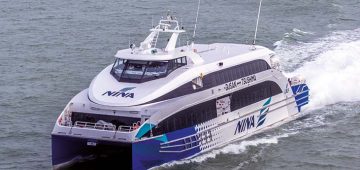Brittany Ferries’ 29,468gt/2009 built Armorique transferred from her Plymouth- Roscoff sailings to Cherbourg-Poole for 8 days from 20th November covering for the Barfleur’s afloat refit in Cherbourg. The ship operated a repositioning voyage between Plymouth and Cherbourg overnight on 18th November with 26 passengers aboard. The ship encountered Storm Angus, making for a very lively trip! The 20,133gt/1992 built Barfleur resumed sailings from Poole on 29th November.
Caronte & Tourist has reportedly ordered an LNG fuelled double-ended ferry for the Messina-Villa San Giovanni route from the Sefine yard in Turkey for delivery in 2018. The ferry will be 132m long and carry 1500 passengers and 290 cars. The design is from the Toulouse office of the Norwegian naval architects LMG Marin. The LMG 290- DEG design, which is 133m long and 21.5m wide, will have two vehicle decks. The propulsion will be based on a gas-electric system using three dual-fuel engines. Thanks to the vessel’s EU Class B certificate, she will also be able to serve on more exposed routes such as to the Aeolian Islands.
DFDS Seaways’ world’s largest Lego ship was unveiled in London’s Trafalgar Square on 17th November on its tour of prominent ports and cities. The ship’s visit to London coincided with Guinness World Record Day. Built from 1,015,000 Lego bricks and measuring 12 metres in length, the Jubilee Seaways was built to mark the company’s 150th anniversary and has been touring the UK and Europe. It took 900 hours to construct and has officially been awarded the Guinness World Record as the largest ever Lego ship. The ship’s full vital statistics are: Length: 12.035m, Width: 1.67m, Height: 2.72m, Weight: 2,860kg. The Jubilee Seaways was designed by Jesper Aagesen, head of new building at DFDS, and is based on a futuristic concept. Every DFDS staff member was given 20 Lego pieces to build a ‘block’ which Lego artist Warren Elsmore and his team then used to construct the design. The ship made her first appearance in the UK at the Blyth Tall Ships event, and also appeared in Dover on 18th/19th November. The final leg of the journey will see her return to Denmark to be part of an exhibition at Lego World in Copenhagen. The official 150th anniversary of DFDS was 11th December.
Mersey Ferries services encountered problems from October when both the Royal Iris and Snowdrop became unavailable for service due to maintenance and technical issues. The service was suspended until after the Snowdrop had successfully completed sea trials on 15th November following main engine work. The vessel had been receiving routine maintenance in readiness for January’s closure of the Wirral loop line. The Royal Iris only came back into service in October following an incident on a Manchester Ship Canal Cruise in July in which 69 passengers had to be rescued from the vessel after she ran aground off Eastham. Mechanical issues struck almost immediately and the ferry was withdrawn again. While the ferries were out of service, a bus operated between Seacombe ferry terminal and Hamilton Square railway station during commuter times.
Port of Dover recorded its busiest day ever for freight traffic, with 10,558 freight vehicles handled by the Port on 23rd November. That is nearly 500 more than the previous record and is equivalent to four extra ferry loads or nine kilometres of traffic in one day. This freight high builds on a 3% growth in freight during the third quarter of 2016. Following 30% growth in freight in just the past three years, freight traffic is once again increasing at Europe’s busiest ferry port, which handles 17% of the UK’s trade in goods.

Rederij Doeksen contracted Damen Shiprepair Harlingen to carry out the conversion of their 47.15m long freight catamaran Noord-Nederland. The conversion work provides owner Rederij Doeksen with increased capacity to manage seasonal fluctuations in freight demands. The company operates a fleet of passenger ferries that run services between the Dutch mainland and the picturesque Wadden Sea islands of Terschelling and Vlieland. The fleet is complemented by the Noord-Nederland, which serves as a cargo and refuse freighter for the same routes. After the conversion, the 361gt/2002 built Noord-Nederland’s increased capacity will allow Rederij Doeksen to respond more effectively to seasonal fluctuations in freight as well as provide project-based services for construction projects on the islands. The vessel is being extended by 20m and, when completed, she will be 67.25m in length. The owners also specified new engines, new rudders and an additional bow thruster. Completion of the project is expected in late February 2017.
Rederi AB Gotland’s first of two ferries being built in China was launched on 18th November with the provisional name of Visborg.
Swedish Orient Line (SOL) expanded its departure frequency between Gothenburg in Sweden and Zeebrugge in Belgium as from 24th November. The company’s vessels will now depart from Gothenburg seven times a week instead of five. To handle the additional departures, the company chartered the 21,104gt/1998 built Ark Forwarder. The 185m/2,700lm capacity vessel will call at the Gothenburg Ro-Ro Terminal. Apart from SOL, the Ro-Ro companies CLdN and Zeebrugge and Ghent.
Sydney Ferries’ new vessel Catherine Hamlin (above) embarked upon her delivery voyage from builder Incat in Tasmania on 17th November to Sydney Harbour. The twin-hull vessel is based on the traditional Sydney Ferry green-and-gold design but will be faster, with a greater seating capacity than current vessels. More than 60,000 people voted in the competition to name the vessel, with the preferred title going to the 92- year-old obstetrician-gynaecologist Catherine Hamlin. Work has begun on the remainder of the fleet which are due to be delivered throughout 2017.






Comments
Sorry, comments are closed for this item